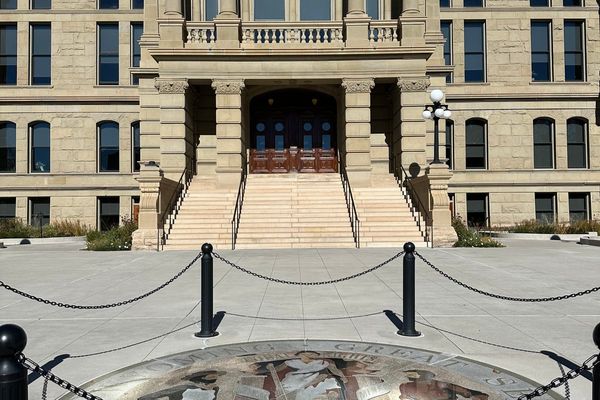
It’s hard to imagine what the irrigated farmland of northern Victoria looked like before colonisation. The land is lasered flat and cut into squares, divided by long, straight roads and the brown ribbons of open irrigation channels.
It’s here, about 70km north of Bendigo, that the Dja Dja Wurrung Clans Aboriginal Corporation (Djaara) aims to make their mark on the Australian agricultural industry. On Friday, at an old dairy farm where everything looks run-down except the modern milking shed, Djaara chief executive Rodney Carter unveiled their plans.
The dairy will be stripped, the parts sold to local farmers, and the old farmhouse converted to a site office and maybe a visitor centre. A low-lying area which has been fighting drainage for decades will be restored into a wetland. Fields of kangaroo grass will be planted and harvested in areas along the levee, because the native grain “doesn’t mind getting wet feet”. And water from the nearby Waranga western irrigation channel, the main draw of this property for Djaara and generations of farmers before them, will be diverted into a network of up to 60 terraced yabby ponds from which 15 tonnes of crayfish will be harvested every year.
Once constructed it will be the biggest yabby farm in the southern hemisphere.
Djaara paid $1.6m for the 80-hectare property, and is still negotiating for water rights with the help of a $3.5m business grant from the Indigenous Land and Sea Council. Carter says there was “some irony” in buying the freehold of land on which native title had been extinguished, but mostly a sense of excitement.

“We’re actually capable and have been good enough at what we’ve done in the last 10 years that we can actually make that active decision [to say]: ‘OK, let’s spend some of our own money’,” he says. “Let’s purchase a property. Let’s do something really cool in aquaculture and not beat ourselves up too much over it.”
The farm is the backbone of a new food and fibre venture, called Djakitj. Initially, Carter says, the organisation was looking for “a more cultural property”, something with some remnant vegetation.
“And in the end, we just landed with probably the most modern property you could think of … just being sensibly practical with what we got,” he says. “What we’re going to do now is Djaara-fy it.”
The ambitious plan for the venture is laid out on an easel which sits above a plastic tub filled with live yabbies. It includes a network of ponds, all flowing into each other, covering most of the property, with a few fields of kangaroo grass growing alongside. There are also plans for a visitor area where people will be able to catch and cook their own yabbies.

Djakitj business manager Dan Duggan invites the crowd at Friday’s launch to imagine a busload of schoolchildren or corporate visitors “learning about our systems, learning about culture, learning about aquaculture, then cooking up a feed of yabbies and going home happy”.
Carter says yabbies “stand alone as a commercial opportunity” but also, as a key species in the ecosystem, will hopefully allow Djaara to expand their business to include yellowbelly and other native fish. They have already secured interest from local restaurants, and Carter says they will selectively breed “monster-size” specimens for the fine-dining market.
“The challenge for us is to make it economically viable, but it also needs to be affordable to people so everyone can enjoy,” he says.
The property, which is at Lockington, “will do us for the one venture for probably the next 20 to 30 years”, Carter says. But the ambition is to keep growing.

“We’re really interested now if we get skin in the game in agriculture,” he says. “We can actually start potentially sticking our neck out and purchase other properties and then extend what we’re doing in farming systems.”
Djakitj aims to build on the work Djaara began in 2020, with a $1.8m project to grow large-scale commercial kangaroo grass crops and figure out how they may be incorporated into existing farming systems.
“It’s able to sustain itself just in Australian-type soils without any inputs and it’s useful in that, if it’s a poor rainfall year, it will still yield something,” Carter says. “So we reckon this is a really useful thing to add to agricultural systems as a product for farmers that are still doing wheat, barley, oats and all those normal things that we need to eat.”
Like yabbies, Carter says, kangaroo grass is a native product with high nutritional value and marketability. He expects to see breads enriched with kangaroo grain in the health-food market soon.
“We’re at a really defining moment historically where my ancestors’ knowledge, our culture, it’s actually useful in terms of the complex problems we’re dealing with particularly with climate change,” he says. “This is what the ancestors did, this is what we’re doing now. We are usefully and purposefully applying it to existing problems, modern problems we’ve got.”
Joshua Gilbert, a Worimi man and agricultural consultant, says that while non-Indigenous farmers are beginning to look for more sustainable agricultural systems, “the real missing link is actually understanding what Indigenous agriculture looks like”.

“We need to unlock the library of 60,000 years of knowledge to weave that into what we’ve learned in the last 200 years to actually redefine what Australian agriculture is going to look like into the future,” he says.
Djakitj is the second aquaculture venture to receive funding from ILSC, after the Emma Nguda Aboriginal Corporation in the Kimberley region in Western Australia, which grows giant freshwater prawns, or cherabin.
ILSC chief executive Joe Morrison, who grew up in Katherine, is more at home with cherabin than yabbies. He is interested in the Djakitj project for what it might mean for Aboriginal water rights.
“This project is one of the first standalone projects where water has been acquired for commercial purposes, not just for cultural use,” Morrison says. “It’s very difficult to acquire those rights in country where water is over-allocated. And there’s still a push to disallow Aboriginal people getting access to water.
For the Dja Dja Wurrung, the farm is the next logical step in caring for both country and people.
“That’s what drives me, that’s what drives us as a people,” Carter says. “And we’re going to collectively go there and lead by example. And I think that’s, it’s so healing to do that.”







